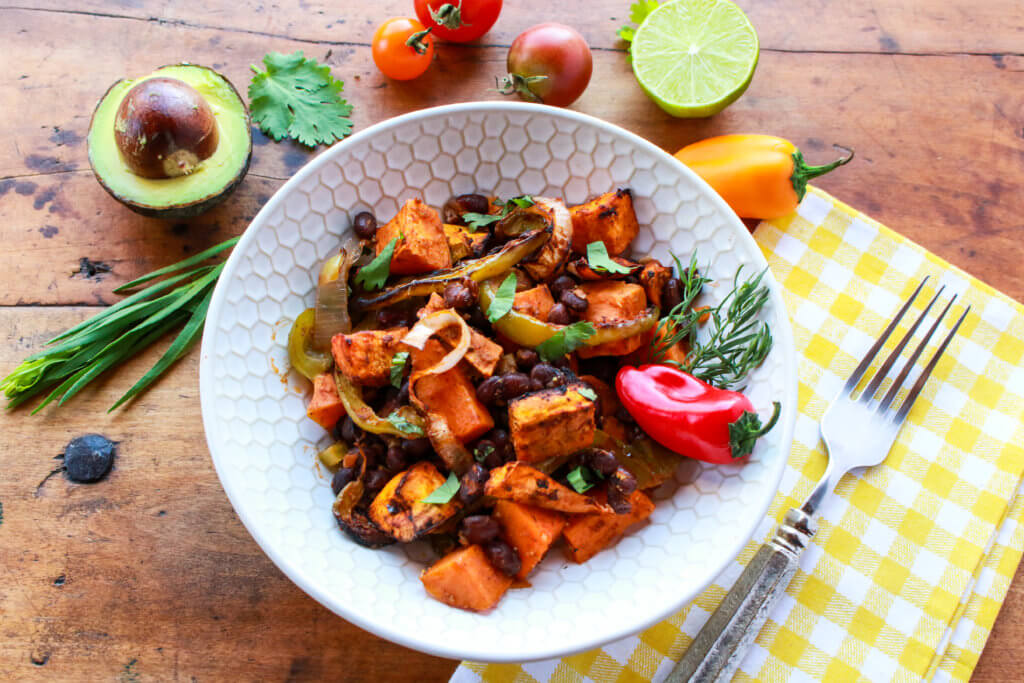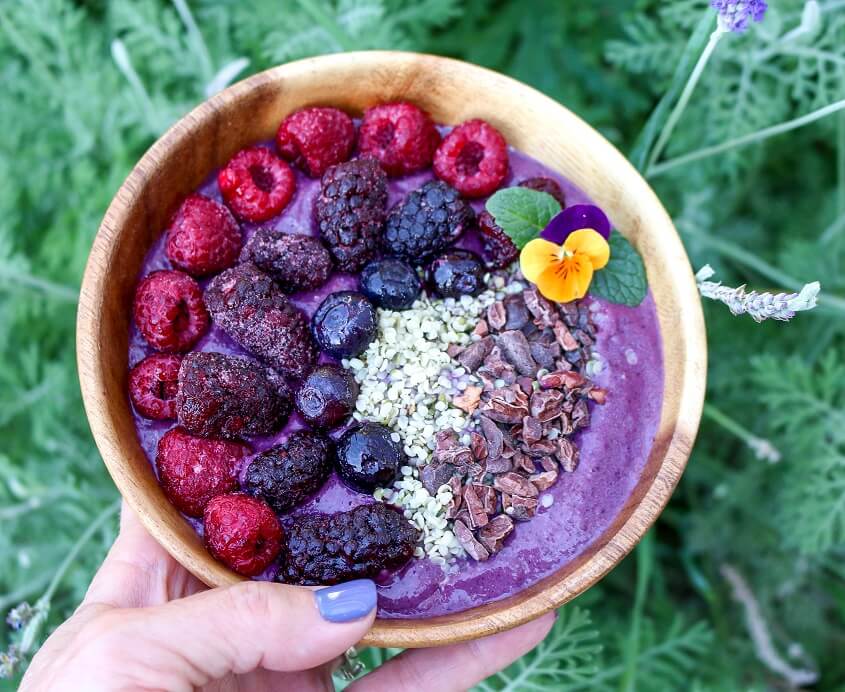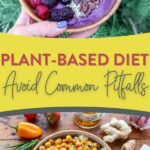How to Avoid Pitfalls When Going Plant-Based

Sharon Palmer, The Plant-Powered Dietitian, addresses the common pitfalls you may face when you start eating a plant-based diet, as well as easy solutions to address them so you can eat a healthy, balanced diet with confidence!
Are you new to plant-based eating and feeling a bit stuck on which foods should be filling your plate? You’re definitely not alone. Plant-based trends are increasing each and every day, but all plant-based diets are certainly not created equal. You can be feasting on a super-healthful plant-based pattern, including balanced meals packed with whole grains, plant proteins, vegetables, fruits, and healthy fats…or you can be hanging out in the refined foods section of the supermarket, looking for vegan cookies, snacks, prepared foods, and frozen desserts. Not that there’s anything wrong with having a treat now and again, but the true beauty of plant-based eating shines forth in a diet filled with whole plant foods! Other pitfalls can await you too, such as not keeping a well-stocked pantry, forgetting to plan for healthy meals, and lacking culinary inspiration. But have no fear, it’s not that difficult to make the most of your plant-based eating pattern with a little know-how. Learn more about the relationship between specific plant foods and the nutrients that each one provides your body for healthy living. When you can understand this positive correlation, you will be motivated to plan, prepare, and cook home-made, nutrient-packed meals that are great for your body too. So, what should you consider when you’re making the switch to plant-based meals? Read on as I answer your top questions on common pitfalls—and solutions—for plant-based eating.
How to Avoid Pitfalls When Going Plant-Based

Question: What are the main reasons and health benefits for going plant-based in the first place?
Sharon’s Answer: The research shows that plant-based diets are linked with lower risks of obesity, hypertension, type 2 diabetes, heart disease, and certain types of cancer. They can also reduce your blood cholesterol, blood pressure, blood glucose, and inflammation levels.
Question: Why do you personally think plant-based eating plans are the way to go? Why do you think more and more people are choosing this lifestyle? Is this the way of the future?
Sharon’s Answer: I was raised in a primarily plant-based home, for religious reasons. We didn’t yet understand all of the health benefits that were going to come as a result of plant-based diets. I studied nutrition at Loma Linda University, now the original Blue Zone in the US. It was a meat-free campus way back then. Now this university has created landmark studies that demonstrate numerous health benefits for plant-based diets, including lower carbon footprint. Even the Dietary Guidelines from the government recommends plant-based diets now. We have gone from worrying about whether plant-based diets are healthy and meet your nutrients, to knowing that they offer multiple benefits. For me, I know that my diet pattern is linked with the lowest environmental footprint possible, the lowest harm to animals, and maximum health benefits. This is the power of the plate. I have been eating completely plant-based for 10 years now. Before that I was vegetarian, and before that I was pescatarian. I believe that making gradual shifts can work for a lot of people. It’s a personal choice. I speak with a lot of people who are interested in eating more plant-based—even if it is gradual. I believe this trend is here to stay, especially with our concern for planetary health.

Question: What are some common pitfalls of jumping into a plant-based lifestyle without properly educating yourself and planning for success?
Sharon’s Answer: I see people who are not prepared, so they don’t eat balanced diets, and feel unwell and give up. You must be prepared. Learn how to eat a balanced diet so you feel vibrant and satisfied. Here are a few key pitfalls and tips.
- You must stock your pantry well with the essentials so you can create healthy meals at all times. Many of the essentials are shelf stable and budget friendly, such as whole grains, nuts, seeds, beans. Then add fresh vegetables/fruits, tofu, plant milks to round it out.
- People often eat a lot of junk vegan food, but that means you are replacing the nutrients you need with low-nutrient foods, so you aren’t gaining the benefits of eating plant-based. The diet isn’t just about avoiding meat, it’s about eating healthy, whole plant foods.
- A lot of people are overly reliant on processed meat alternatives. These are fine occasionally, but it’s better if you can learn to cook with whole plant foods, like beans, lentils, tofu, vegetables, grains. That’s where the true benefits lie.
- Don’t just eat veggies for your meals, you’ll be falling short on a balanced diet with proteins, carbs, healthy fats, vitamins, minerals. You need to balance your plate with all groups: proteins, veggies, fruits, grains, healthy fats.
Question: What are some considerations for switching to a plant-based meal plan that you should think through BEFORE you dive in?
Sharon’s Answer: Here are a few of my top considerations and suggestions:
- Read a good book on starting a plant-based diet, which will talk about how to plan for a balanced, healthy diet that meets your nutrient needs.
- Set up your pantry for success and to support a plant-based diet—make sure to have the staples on hand.
- Try a few plant-based recipes in advance so that you are familiar with plant-based meals you can make in a cinch.
- Find plant-based offerings in local restaurants and markets in advance.
- Make sure to get on a supplement regimen, at least B12, and others considering your diet pattern; for example, you need to get calcium in your diet, if you are falling short a supplement can help.
- Don’t go too high fiber all at once—if you up your fiber all at once, you may have temporary GI issues, so gradually increase your intake of whole grains, beans, nuts, seeds, veggies to get used to it.
- Plan for healthful, protein-rich snacks to have on hand if you get hungry.
- Make sure you get enough protein and fat—those two shortfalls can make you feel low energy and hungry.

Question: What do you suggest for a step-by-step guide on HOW to create a healthy plant-based diet plan?
Sharon’s Answer: You can try some of my blogs and resources; see if they help:
- I have a Go Vegan toolkit, Plant Protein list, and Pantry list for free downloads. I have sample meal plans in the vegan toolkit.
- I have a series of blogs on vegan/vegetarian diet here, such as going from vegetarian to vegan, nutrients of concern, B12, budget-friendly eating, and more.
- I have tons of plant-based recipes you can use; they are vegan.
- Check out my books The Plant-Powered Diet, Plant-Powered for Life, and California Vegan.
Question: What are some nutrient powerhouses to highlight regularly in a healthy plant-based diet?
Sharon’s Answer: Here are the basics:
- Whole grains—Stock a variety of these to enjoy at each meal, these can be intact grains, such as brown rice, oats, quinoa, farro, sorghum, and they can be the base of a healthy meal, filled with nutrients and even protein. Plus they are packed with fiber, which can provide health benefits.
- Green leafy veg—I recommend these every day to provide minerals, such as calcium, and so many nutrients. In particular, the cruciferous green veggies, like kale, broccoli are good sources of plant-based calcium. They are also low in calories, and so versatile, can enjoy cooked or raw.
- Nuts and seeds—try to have a couple of handfuls per day for healthy fats (even omega-3s), plus protein. Try to include them in meals like with cereal, salads, sandwiches or as a snack. Also nut and seed butters. Peanut butter is a legume, but it also applies here.
- Tofu—this minimally processed plant food is rich in protein, and very versatile. It’s linked with health benefits too. I try to include tofu in at least a few meals per week. It’s so easy to include in recipes like stir-fries, casseroles, and curry dishes.
- Tempeh—this minimally processed plant food is also rich in protein, and it’s very easy to use in sandwich fillings, and recipes in place of meat. It’s based on soy, so I try to include it a couple of times per week.
- Soy Milk—include this as your preferred plant milk as it’s rich in protein, and the fortified one has vitamin D and calcium too. Add to cereals, coffee, baked goods, sauces, smoothies.
- Seasonal Veg and Fruit—Include a variety at every meal based on the season—the greater the variety the better for health. Packed with phytochemicals which are linked with health protection. Include fresh, in salads, cooked, and in recipes.

Question: What supplements might one need to round out their nutritional profile after eliminating animal products?
Sharon’s Answer: Here are my recommendations:
- I recommend that everyone should have B12 if they eat a completely plant-based diet at levels of 1000 mcg twice per week.
- If you are falling short of calcium, you might want to consider a small supplement of about 500 mg per day. But if you are eating fortified foods and are getting plenty of plant-based calcium this may not be needed.
- I also recommend a plant-based multi supplement that provides just what you might need, such as Wholier, which only provides the nutrients that could be falling short. Vegans get plenty of vitamin C, E, and A, for example, so why supplement those? I recommend no more than 100% of the DV for nutrients, such as iron, zinc, selenium that could be in this multi.
- Iodine may be falling short, so you might want to ensure that your plant-based multi has that. 100% RDA is good.
- Choline also may be falling short, so you might want to supplement that a few times per week, or make sure it’s in your multi.
- Vitamin D is a shortfall nutrient for all Americans. You can get it by sun exposure, but you can also get it in mushrooms exposed to light and fortified foods. And you can also consider supplementing it or make sure it’s in your multi. Supplement with 100% RDA.
- Omega-3s can be found in walnuts, chia, hemp, and soy foods. But it might be a good idea to get EPA and DHA through algae supplements about 250 mg per day.
Try some of my favorite plant-based recipes:
Jade Edamame Brussels Sprout Rice Bowl
Nourish Lentil Bowl
Sweet Potato Black Bean Bake
Creamy Chickpea Curry
Check out the other nutrition questions I’m answering at The Plant-Powered Dietitian:
Can Cutting Sugar Reduce Taste For It?
Can I Be Deficient in Vitamin A?
Are Plant-Based Diets Good for Diabetes?
Do I Have to Get All of My Required Nutrients in One Day?



